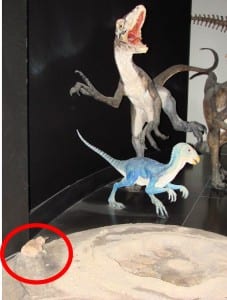Specimen of the Week 190: The Platypus Tooth
By Jack Ashby, on 1 June 2015
I have to admit that when I first encountered this object I didn’t recognise what it was until I read the label, which is scratched into the glass slide that houses it. I don’t feel too bad about that as it is essentially microscopic, and very few people have ever seen one of these specimens. It is among the very smallest objects in the Museum.
Unsurprisingly then, it is on display in the Micrarium – our place for tiny things. This beautiful back-lit cave showcases over 2000 of the 20,000 microscope slides in our care – it broke the mould for how museums display their slide collections.
I first wrote about the species featured on this slide in my first ever Specimen of the Week, but that was taxidermy – a real A-Lister compared to the miniscule, obscure fragment I have selected here. This week’s Specimen of the Week is…
**The Platypus Tooth**

The skull and mandible of an adult platypus showing
the horny plates on the jaw. These are not teeth. LDUCZ-Z715
1) The tooth of a toothless animal
The most important thing to know about platypus teeth is that platypuses don’t have teeth, which makes this specimen all the more special.
Platypuses have a leathery bill, supported by thin struts of bone – heavily reduced and modified from the ancestral mammalian singular lower jawbone (that we have, for example). Instead of teeth the bill houses a series of horny plates which they use to crush and chew their invertebrate prey (largely crustaceans and worms).
2) Baby teeth
However, for a period during the development of a platypus foetus, they do temporily start to grow teeth which are soon re-absorbed into the skull. This is an interesting reverse of what most animals do – to have babies with no teeth and then adults with teeth.
It is from the historic dissection of a toothed platypus embryo that this specimen originates.
3) Fangs for the memories
The toothless state of adult platypuses is one of the many heavily modified characterstics that they display. In some respects platypuses (and their equally toothless relatives, echidnas) share a lot of features with the (toothed) reptile-like creatures that mammals evolved from; features which have been modified or lost in the other mammal groups, placentals and marsupials. For this reason they are often described as “primitive”, however evolving the loss of teeth – as well as electro-reception and being venomous – is a highly derived characteristic that has taken them far away from their ancient forebears.
4) Tooth of contention
For over a century, the study of how early fossil mammals and their ancestors are related to each other has relied heavily on comparing the arrangement of the cones and ridges that make up teeth. This is because teeth are very tough and fossilise well, unlike the rest of the skeleton of these animals, which were mostly tiny. Also, teeth vary a lot over the course of mammal evolution so are particularly useful.
This is rather unfortunate for those trying to establish the position of early monotremes (the egg-laying mammals, of which the platypus and echidnas are the sole surviving members). Without any teeth, and a relatively poor fossil record, the postition of platypuses on the mammal family tree has proved extremely hard to pin down. Embryonic teeth like this specimen can only go so far.
5) The Lightning-Toothed Platypus
In the early 1980s a fragment of 105 million year old opalised fossil bone containing three molars was discovered at Lightning Ridge in New South Wales. It was described as Steropodon (“lightning tooth”) – the earliest known fossil mammal from Australia, and a member of the monotremes. Despite the fragmentary nature of this fossil the animal is believed to be very platypus-like in appearance, and around 50cm long. This would have made it one of the largest mammals alive in the Cretaceous. As such, it almost features prominently in a dinosaur display at the Australian Museum.
Jack Ashby is the Manager of the Grant Museum of Zoology.
References
Archer, M., Flannery, T.F., Ritchie, A., Molnar, R.E. (1985). “First Mesozoic mammal from Australia — an early Cretaceous monotreme”. Nature 318: 363-366.
One Response to “Specimen of the Week 190: The Platypus Tooth”
- 1
 Close
Close




Hi my name is Shannon and I have a platypus skull you would be interested in. The skull is very unique, in appearance it is not white bone anymore but has fossilised and turned dark and hardened. It is only the top of the skull but still worth a look. What would something like this be worth or who is the right people to show